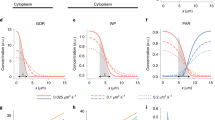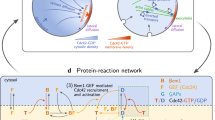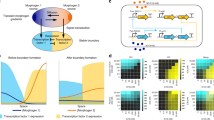Abstract
Diverse cell polarity networks require positive feedback for locally amplifying distributions of signalling molecules at the plasma membrane1. Additional mechanisms, such as directed transport2 or coupled inhibitors3,4, have been proposed to be required for reinforcing a unique axis of polarity. Here we analyse a simple model of positive feedback, with strong analogy to the ‘stepping stone’ model of population genetics5, in which a single species of diffusible, membrane-bound signalling molecules can self-recruit from a cytoplasmic pool. We identify an intrinsic stochastic mechanism through which positive feedback alone is sufficient to account for the spontaneous establishment of a single site of polarity. We find that the polarization frequency has an inverse dependence on the number of signalling molecules: the frequency of polarization decreases as the number of molecules becomes large. Experimental observation of polarizing Cdc42 in budding yeast is consistent with this prediction. Our work suggests that positive feedback can work alone or with additional mechanisms to create robust cell polarity.
This is a preview of subscription content, access via your institution
Access options
Subscribe to this journal
Receive 51 print issues and online access
$199.00 per year
only $3.90 per issue
Buy this article
- Purchase on Springer Link
- Instant access to full article PDF
Prices may be subject to local taxes which are calculated during checkout



Similar content being viewed by others
References
Drubin, D. G. & Nelson, W. J. Origins of cell polarity. Cell 84, 335–344 (1996)
Wedlich-Soldner, R. et al. Spontaneous cell polarization through actomyosin-based delivery of the Cdc42 GTPase. Science 299, 1231–1235 (2003)
Gierer, A. & Meinhardt, H. A theory of biological pattern formation. Kybernetik 12, 30–39 (1972)
Turing, A. M. The chemical basis of morphogenesis. Phil. Trans. R. Soc. B 237, 37–72 (1952)
Kimura, M. & Weiss, G. H. The stepping stone model of population structure and the decrease of genetic correlation with distance. Genetics 49, 561–576 (1964)
Ebersbach, G. & Jacobs-Wagner, C. Exploration into the spatial and temporal mechanisms of bacterial polarity. Trends Microbiol. 15, 101–108 (2007)
Sohrmann, M. & Peter, M. Polarizing without a c(l)ue. Trends Cell Biol. 13, 526–533 (2003)
Wedlich-Soldner, R. et al. Robust cell polarity is a dynamic state established by coupling transport and GTPase signaling. J. Cell Biol. 166, 889–900 (2004)
Butty, A. C. et al. A positive feedback loop stabilizes the guanine-nucleotide exchange factor Cdc24 at sites of polarization. EMBO J. 21, 1565–1576 (2002)
Shi, S. H., Jan, L. Y. & Jan, Y. N. Hippocampal neuronal polarity specified by spatially localized mPar3/mPar6 and PI 3-kinase activity. Cell 112, 63–75 (2003)
Gassama-Diagne, A. et al. Phosphatidylinositol-3,4,5-trisphosphate regulates the formation of the basolateral plasma membrane in epithelial cells. Nature Cell Biol. 8, 963–970 (2006)
Weiner, O. D. et al. A PtdInsP3- and Rho GTPase-mediated positive feedback loop regulates neutrophil polarity. Nature Cell Biol. 4, 509–513 (2002)
Brandman, O. et al. Interlinked fast and slow positive feedback loops drive reliable cell decisions. Science 310, 496–498 (2005)
Irazoqui, J. E., Gladfelter, A. S. & Lew, D. J. Scaffold-mediated symmetry breaking by Cdc42p. Nature Cell Biol. 5, 1062–1070 (2003)
Marco, E. et al. Endocytosis optimizes the dynamic localization of membrane proteins that regulate cortical polarity. Cell 129, 411–422 (2007)
Ozbudak, E. M., Becskei, A. & van Oudenaarden, A. A system of counteracting feedback loops regulates Cdc42p activity during spontaneous cell polarization. Dev. Cell 9, 565–571 (2005)
Kozlov, M. M. & Mogilner, A. Model of polarization and bistability of cell fragments. Biophys. J. 93, 3811–3819 (2007)
Krishnan, J. & Iglesias, P. A. Receptor-mediated and intrinsic polarization and their interaction in chemotaxing cells. Biophys. J. 92, 816–830 (2007)
Fivaz, M. et al. Robust neuronal symmetry breaking by Ras-triggered local positive feedback. Curr. Biol. 18, 44–50 (2008)
Levin, S. A. in Pattern Formation by Dynamic Systems and Pattern Recognition (ed. Haken, H.) 210–222 (Springer, Berlin, 1979)
Qian, H., Saffarian, S. & Elson, E. L. Concentration fluctuations in a mesoscopic oscillating chemical reaction system. Proc. Natl Acad. Sci. USA 99, 10376–10381 (2002)
Samoilov, M. S., Price, G. & Arkin, A. P. From fluctuations to phenotypes: the physiology of noise. Sci. STKE 2006, re17 (2006)
Suel, G. M. et al. Tunability and noise dependence in differentiation dynamics. Science 315, 1716–1719 (2007)
Elf, J. & Ehrenberg, M. Spontaneous separation of bi-stable biochemical systems into spatial domains of opposite phases. Syst. Biol. 1, 230–236 (2004)
Bose, I. et al. Assembly of scaffold-mediated complexes containing Cdc42p, the exchange factor Cdc24p, and the effector Cla4p required for cell cycle-regulated phosphorylation of Cdc24p. J. Biol. Chem. 276, 7176–7186 (2001)
Shimada, Y. et al. The nucleotide exchange factor Cdc24p may be regulated by auto-inhibition. EMBO J. 23, 1051–1062 (2004)
Chisari, M. et al. Shuttling of G protein subunits between the plasma membrane and intracellular membranes. J. Biol. Chem. 282, 24092–24098 (2007)
DerMardirossian, C. & Bokoch, G. M. GDIs: central regulatory molecules in Rho GTPase activation. Trends Cell Biol. 15, 356–363 (2005)
Bustelo, X. R., Sauzeau, V. & Berenjeno, I. M. GTP-binding proteins of the Rho/Rac family: regulation, effectors and functions in vivo . Bioessays 29, 356–370 (2007)
Ayscough, K. R. et al. High rates of actin filament turnover in budding yeast and roles for actin in establishment and maintenance of cell polarity revealed using the actin inhibitor latrunculin-A. J. Cell Biol. 137, 399–416 (1997)
Acknowledgements
We thank M. Altschuler, A. Artyukhin, T. Kurtz, C. Neuhauser, M. Rosen, R. Ranganathan, B. Shraiman, G. Süel and O. Weiner for their positive feedback. We additionally thank P. Crews for latrunculin A and R. Li for the yeast strain. This research was supported by an NIH grant (RO1 GM071794), an NSF grant (DMS 0405084), the Endowed Scholars program at UT Southwestern Medical Center, and the Welch Foundation (I-1619, I-1644).
Author information
Authors and Affiliations
Corresponding authors
Supplementary information
Supplementary information
The file contains Supplementary Results and Supplementary Figures S1-S3 with Legends. (PDF 4694 kb)
Rights and permissions
About this article
Cite this article
Altschuler, S., Angenent, S., Wang, Y. et al. On the spontaneous emergence of cell polarity. Nature 454, 886–889 (2008). https://doi.org/10.1038/nature07119
Received:
Accepted:
Issue Date:
DOI: https://doi.org/10.1038/nature07119
This article is cited by
-
Patterning of the cell cortex by Rho GTPases
Nature Reviews Molecular Cell Biology (2024)
-
Redundancy and the role of protein copy numbers in the cell polarization machinery of budding yeast
Nature Communications (2023)
-
A Becker–Döring Type Model for Cell Polarization
Journal of Statistical Physics (2023)
-
Mathematical Modeling of Cell Polarity Establishment of Budding Yeast
Communications on Applied Mathematics and Computation (2023)
-
Effect of Spatial Average on the Spatiotemporal Pattern Formation of Reaction-Diffusion Systems
Journal of Dynamics and Differential Equations (2022)
Comments
By submitting a comment you agree to abide by our Terms and Community Guidelines. If you find something abusive or that does not comply with our terms or guidelines please flag it as inappropriate.



